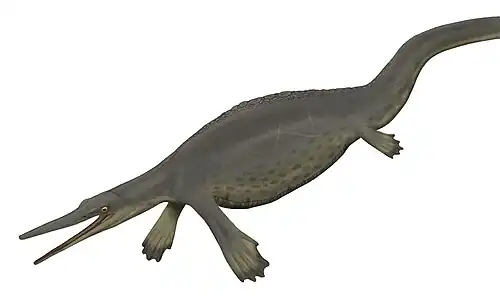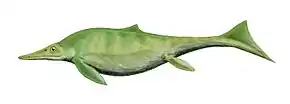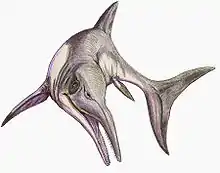| Guanlingsaurus Temporal range: Late Triassic, | |
|---|---|
 | |
| Juvenile specimen YGMIR SPCV03108 | |
| Scientific classification | |
| Domain: | Eukaryota |
| Kingdom: | Animalia |
| Phylum: | Chordata |
| Class: | Reptilia |
| Order: | †Ichthyosauria |
| Suborder: | †Longipinnati |
| Node: | †Merriamosauria |
| Family: | †Shastasauridae |
| Genus: | †Guanlingsaurus Yin et al., 2000 |
| Type species | |
| †Guanlingsaurus liangae Yin et al., 2000 | |
| Synonyms | |
Guanlingsaurus is an extinct genus of shastasaurid ichthyosaur from the Late Triassic of China. It grew up to 8.3 metres (27 ft) in length and has a wide, triangular skull with a short and toothless snout.
Discovery

It is known from a single species, Guanlingsaurus liangae, that was found in the Carnian-age Falang Formation of Guanling County, which is in the province of Guizhou. The genus and species were first named in 2000 on the basis of an incomplete adult skeleton. More complete skeletons were described in 2011, and a complete skeleton belonging to a juvenile was described in 2013. In 2011 Guanlingsaurus liangae was reassigned to the genus Shastasaurus, which includes two species from North America that are known from more complete fossils than Guanlingsaurus. However, the description of the juvenile specimen in 2013 revealed several features that make G. liangae distinct from Shastasaurus species, and the name was reinstated.[4]
Description

The largest specimen of Guanlingsaurus, YIGMR SPCV03109, measures 8.3 metres (27 ft) long,[5] while the juvenile specimen YIGMR SPCV03108 measures 3.74 metres (12.3 ft) in length.[5] In the largest specimen, YIGMR SPCV03109, the skull takes up 8.3% of the total body length, whereas it forms 9.3% in the juvenile specimen YIGMR SPCV03108. Both adult and juvenile specimens of Guanlingsaurus completely lack teeth and do not even possess a dental groove. The very short snout was highly compressed via a unique arrangement of skull bones. All bones of the snout tapered to abrupt points. In 2011, Sander and colleagues interpreted the nasal bones (paired skull roof bones in the middle part of the skull) as extending to the very tip of the snout, a very unusual configuration for a reptile.[5] However, Ji and colleagues did not find this feature.[4]
Classification
Below is a cladogram from Fröbisch et al. (2013) showing Guanlingsaurus liangae as a species of Shastasaurus:[6]
| Ichthyopterygia |
| |||||||||||||||||||||||||||||||||||||||||||||||||||||||||||||||||||||||||||||||||||||||||||||||||||||||||||||||||||||||||||
References
- ↑ "†Guanlingsaurus Yin et al. 2000 (ichthyosaur)". Paleobiology Database. Fossilworks. Retrieved 17 December 2021.
- ↑ Maisch, M. W.; Pan, X. R.; Sun, Z. Y.; Cai, T.; Zhang, D. P.; Xie, J. L. (2006). "Cranial osteology of Guizhouichthyosaurus tangae (Reptilia: Ichthyosauria) from the Upper Triassic of China". Journal of Vertebrate Paleontology. 26 (3): 588–597. doi:10.1671/0272-4634(2006)26[588:COOGTR]2.0.CO;2.
- ↑ Shang, Q. H.; Li, C. (2009). "On the occurrence of the ichthyosaur Shastasaurus in the Guanling biota (Late Triassic), Guizhou, China" (PDF). Vertebrata PalAsiatica. 47 (3): 178–193.
- 1 2 Ji, C.; Jiang, D. Y.; Motani, R.; Hao, W. C.; Sun, Z. Y.; Cai, T. (2013). "A new juvenile specimen of Guanlingsaurus (Ichthyosauria, Shastasauridae) from the Upper Triassic of southwestern China". Journal of Vertebrate Paleontology. 33 (2): 340. doi:10.1080/02724634.2013.723082. S2CID 83784699.
- 1 2 3 Sander P, Chen X, Cheng L, Wang X (2011). Claessens L (ed.). "Short-Snouted Toothless Ichthyosaur from China Suggests Late Triassic Diversification of Suction Feeding Ichthyosaurs". PLOS ONE. 6 (5): e19480. Bibcode:2011PLoSO...619480S. doi:10.1371/journal.pone.0019480. PMC 3100301. PMID 21625429.
- ↑ Fröbisch, N. B.; Fröbisch, J. R.; Sander, P. M.; Schmitz, L.; Rieppel, O. (2013). "Macropredatory ichthyosaur from the Middle Triassic and the origin of modern trophic networks". Proceedings of the National Academy of Sciences. 110 (4): 1393–1397. Bibcode:2013PNAS..110.1393F. doi:10.1073/pnas.1216750110. PMC 3557033. PMID 23297200.








